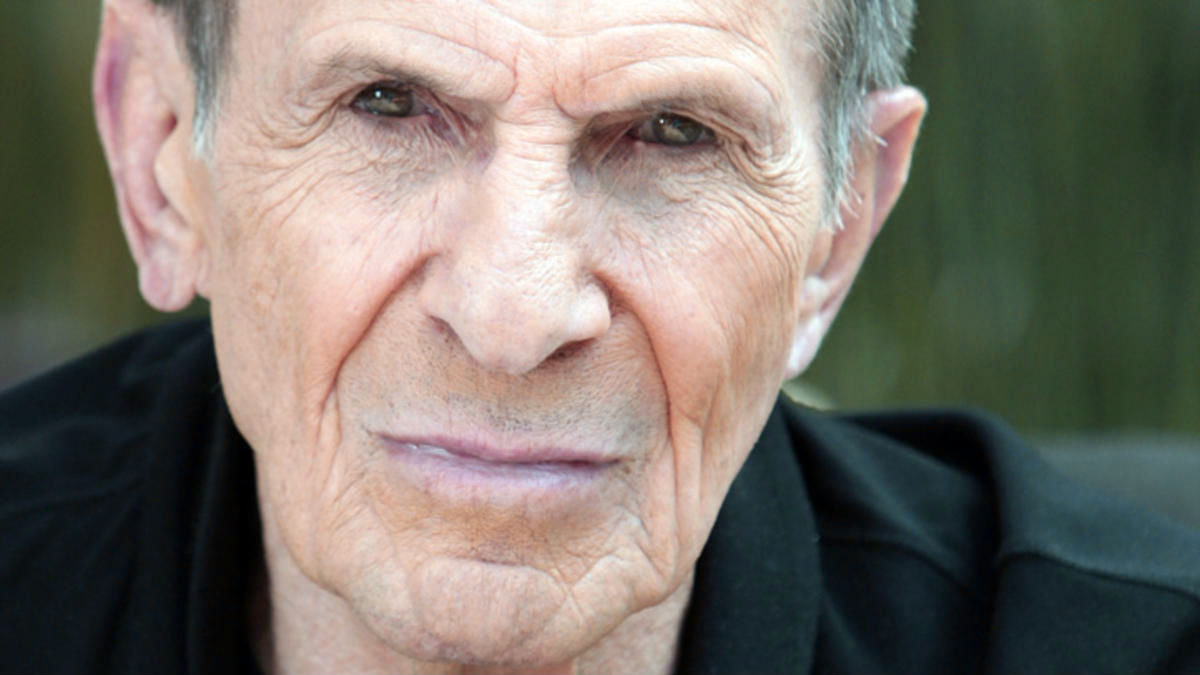“The Vulcan was always with me.”
— Leonard Nimoy
Sometimes acting isn’t about the acting. Sometimes it’s a matter of the right part finding the right actor; more often than not, the right part and the right actor just miss each other, due to egos, poor timing, or just plain bad luck. What would Cary Grant have been like as James Bond, if he’d been a decade or two younger? Or W.C. Fields as the Wizard of Oz? Orson Welles as Mr. Kurtz in his aborted version of Heart of Darkness?
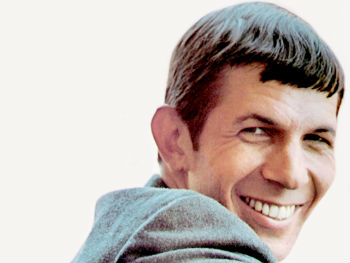 Fortunately, we don’t have to play the what-if game with the late Leonard Nimoy. It’s no secret that he was always just a little ambivalent about being so closely identified with Mr. Spock, the half-Vulcan, half-human first officer of the USS Enterprise — probably because Mr. Spock didn’t have much in common with Leonard Nimoy. And yet, thanks to that rare alchemy that can happen when a particular actor meets a particular role, Nimoy and Spock found each other, and the resulting performance cements Nimoy/Spock as one of the great characters.
Fortunately, we don’t have to play the what-if game with the late Leonard Nimoy. It’s no secret that he was always just a little ambivalent about being so closely identified with Mr. Spock, the half-Vulcan, half-human first officer of the USS Enterprise — probably because Mr. Spock didn’t have much in common with Leonard Nimoy. And yet, thanks to that rare alchemy that can happen when a particular actor meets a particular role, Nimoy and Spock found each other, and the resulting performance cements Nimoy/Spock as one of the great characters.
A lanky, Method-y talent, and very much an emotional guy, Nimoy embodied the ’60s hipster: catch him in any of his early TV roles, such as his guest appearance in Gene Roddenberry’s The Lieutenant, and what strikes you is the rapid-fire patter, the nervousness, the need to inhabit the moment. He was unashamedly a man of many talents — dramaturge, photographer, poet, theatre man, musician, activist — and that scattered energy comes across in his pre-Star Trek performances. When Roddenberry offered him the chance to play Spock, it was unlike anything he’d ever done, for better and worse. Better because here was a character with no set rulebook, where the galaxy was literally the limit — manna for any ambitious actor. Worse because if he failed, he’d forever be pegged as the guy who played the clownish alien on that silly space show.
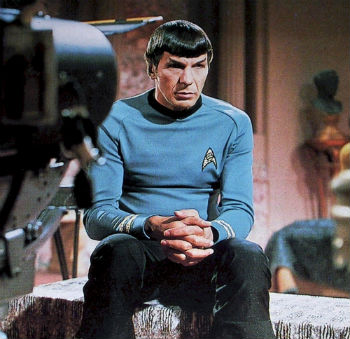 What happened next is history, but it’s easy to forget that Spock wasn’t built in a day. Watch the early episodes of Star Trek‘s first season and you see an actor feeling his way into a part, much like Roddenberry and company were reinventing sci-fi genre TV on the fly. For an officer who prided himself on logic and rationalism, Spock was awfully passionate in his first few appearances. “Quite unnecessary to shout, Mr. Bailey,” he would say at one moment, and in the next he would be roaring red alerts at the bridge crew. Nimoy’s edginess was at direct odds with the character’s reserve, and while that edginess, properly submerged, would become key to Spock’s success, he had yet to find the right balance. Then came along episode 4, “The Naked Time,” wherein Spock is infected with a virus that strips away his emotional inhibitions. Given a long monologue in which he wars with himself, the sensitive human and the stoic Vulcan finally having their day in court, Nimoy knew he had found a crucial moment in defining the character, and was dismayed to learn that the moment would be cut due to tight film scheduling. He cajoled the director into giving him one chance to perform the scene, one long tracking shot, one take. The resulting outburst is like a cleansing thunderstorm; the catharsis gave Nimoy the confidence to dial his performance down from that point forward, and discover the drama in Spock’s stillness.
What happened next is history, but it’s easy to forget that Spock wasn’t built in a day. Watch the early episodes of Star Trek‘s first season and you see an actor feeling his way into a part, much like Roddenberry and company were reinventing sci-fi genre TV on the fly. For an officer who prided himself on logic and rationalism, Spock was awfully passionate in his first few appearances. “Quite unnecessary to shout, Mr. Bailey,” he would say at one moment, and in the next he would be roaring red alerts at the bridge crew. Nimoy’s edginess was at direct odds with the character’s reserve, and while that edginess, properly submerged, would become key to Spock’s success, he had yet to find the right balance. Then came along episode 4, “The Naked Time,” wherein Spock is infected with a virus that strips away his emotional inhibitions. Given a long monologue in which he wars with himself, the sensitive human and the stoic Vulcan finally having their day in court, Nimoy knew he had found a crucial moment in defining the character, and was dismayed to learn that the moment would be cut due to tight film scheduling. He cajoled the director into giving him one chance to perform the scene, one long tracking shot, one take. The resulting outburst is like a cleansing thunderstorm; the catharsis gave Nimoy the confidence to dial his performance down from that point forward, and discover the drama in Spock’s stillness.
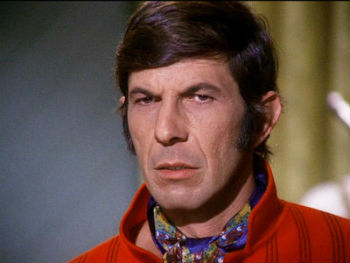 Nimoy had a moderately fruitful acting career, most notably on Mission: Impossible, but he was never persuasive playing a regular human. With those vaguely Asiatic features, his stiff bearing and that baritone voice, he was meant to play roles that were otherworldly (it’s no surprise that he was in his element as the narrator of the In Search Of… series, which was all about the paranormal). Probably his best moment away from Spock was in Philip Kaufman’s remake of Invasion of the Body Snatchers (1978) — in a sly joke of a performance, his portrayal of a cool psychologist and then as the alien who takes over his body were virtually the same. “Don’t be trapped by old concepts,” he purrs, aping the New-Agey advice of the era, even as he prepares to suck the life away from Donald Sutherland.
Nimoy had a moderately fruitful acting career, most notably on Mission: Impossible, but he was never persuasive playing a regular human. With those vaguely Asiatic features, his stiff bearing and that baritone voice, he was meant to play roles that were otherworldly (it’s no surprise that he was in his element as the narrator of the In Search Of… series, which was all about the paranormal). Probably his best moment away from Spock was in Philip Kaufman’s remake of Invasion of the Body Snatchers (1978) — in a sly joke of a performance, his portrayal of a cool psychologist and then as the alien who takes over his body were virtually the same. “Don’t be trapped by old concepts,” he purrs, aping the New-Agey advice of the era, even as he prepares to suck the life away from Donald Sutherland.
Spock might have been a constrictive personality on the surface of it, but it was also a bonanza of opportunities for Nimoy. Most actors salivate at the idea of developing a role over the span of a TV series; Nimoy also created an entire race and culture based off his portrayal. From the Vulcan nerve pinch to the hand salute stolen from a boyhood memory of Jewish ceremonies, right down to the “Live long and prosper” catchphrase, he set the template for every actor who would play a Vulcan after him. While the other Star Trek characters would get their moments in the sun, Spock received a full backstory, including episodes devoted entirely to his parents (“Journey to Babel”) and his mating rituals (“Amok Time”). The Spock template might have been limiting in some ways, but it gave Nimoy the ideal canvas on which to develop his gravitas, his deadpan comic timing, the flickers of genuine feeling beneath the facade.
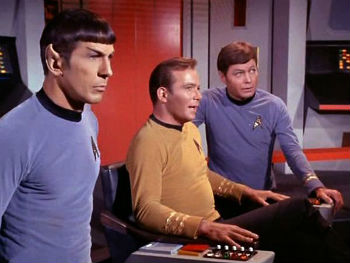 It wasn’t easy being green-blooded — forcing himself into character even on the weekends, Nimoy would eventually chafe under the strictures of the role, and even resorted to drink to get him through the day. Still, Spock was a prime reason why Star Trek became a cultural phenomenon. Here was a show that dared to have an optimistic view of the future during the tumultuous late ’60s, that was comfortable being out of step with orthodoxy (a Russian member of the crew? At the time it seemed almost as outrageous as having a Klingon on the bridge), that was the first to bring an interracial kiss to television, and that had a character like Spock, who could be acknowledged as something Other and yet also accepted as one of the family. A closet hippie himself (check out “The Ballad of Bilbo Baggins“), Nimoy had stumbled into the Zeitgeist through the unlikeliest path. Just as importantly, the central triumvirate of Captain Kirk, Spock and Dr. McCoy gave the series an emotional core that no succeeding Star Trek series has duplicated, and Nimoy, tamping it down while William Shatner and DeForest Kelley chewed up the scenery, was the grounding force that made it all possible.
It wasn’t easy being green-blooded — forcing himself into character even on the weekends, Nimoy would eventually chafe under the strictures of the role, and even resorted to drink to get him through the day. Still, Spock was a prime reason why Star Trek became a cultural phenomenon. Here was a show that dared to have an optimistic view of the future during the tumultuous late ’60s, that was comfortable being out of step with orthodoxy (a Russian member of the crew? At the time it seemed almost as outrageous as having a Klingon on the bridge), that was the first to bring an interracial kiss to television, and that had a character like Spock, who could be acknowledged as something Other and yet also accepted as one of the family. A closet hippie himself (check out “The Ballad of Bilbo Baggins“), Nimoy had stumbled into the Zeitgeist through the unlikeliest path. Just as importantly, the central triumvirate of Captain Kirk, Spock and Dr. McCoy gave the series an emotional core that no succeeding Star Trek series has duplicated, and Nimoy, tamping it down while William Shatner and DeForest Kelley chewed up the scenery, was the grounding force that made it all possible.
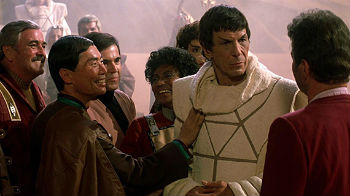 It would take Nimoy a full decade to get past his angst over being constantly associated with Spock. “I am not Spock,” he told us in his book of the same title, and he would take on roles that tried to remind us (and him) of that fact: Sherlock Holmes on Broadway, a murderer on Columbo, a pie in the face on Masterjoke Theatre. By the time the Star Trek movies came out, he had mellowed, and so had Spock: now a Zen-like sage who was more in touch with his emotions, he was a reassuring presence, the subtle spikiness of his characterization from the TV series toned down. Still, there were plenty of memorable scenes, like Spock’s death, or a well-timed Vulcan nerve pinch on a San Francisco bus. Oddly enough, Nimoy’s finest moment in these movies might come in Star Trek III: The Search for Spock, in which Spock is onscreen for all of five minutes. Star Trek III isn’t the best of the Trek movies by a long shot, but it might be the most personal, as Nimoy assumed the director’s chair for the first time, and true to his love of acting and actors, gave each member of the original crew a turn in the spotlight. Camaraderie was an essential component of Trek, and Star Trek III at its best is an unabashed celebration of that camaraderie. When the Enterprise crew hijack their own vessel to save their friend Spock’s life, one senses Nimoy grinning behind the scenes, finally unafraid to express his affection for these characters.
It would take Nimoy a full decade to get past his angst over being constantly associated with Spock. “I am not Spock,” he told us in his book of the same title, and he would take on roles that tried to remind us (and him) of that fact: Sherlock Holmes on Broadway, a murderer on Columbo, a pie in the face on Masterjoke Theatre. By the time the Star Trek movies came out, he had mellowed, and so had Spock: now a Zen-like sage who was more in touch with his emotions, he was a reassuring presence, the subtle spikiness of his characterization from the TV series toned down. Still, there were plenty of memorable scenes, like Spock’s death, or a well-timed Vulcan nerve pinch on a San Francisco bus. Oddly enough, Nimoy’s finest moment in these movies might come in Star Trek III: The Search for Spock, in which Spock is onscreen for all of five minutes. Star Trek III isn’t the best of the Trek movies by a long shot, but it might be the most personal, as Nimoy assumed the director’s chair for the first time, and true to his love of acting and actors, gave each member of the original crew a turn in the spotlight. Camaraderie was an essential component of Trek, and Star Trek III at its best is an unabashed celebration of that camaraderie. When the Enterprise crew hijack their own vessel to save their friend Spock’s life, one senses Nimoy grinning behind the scenes, finally unafraid to express his affection for these characters.
Ever the perfectionist, Nimoy was often difficult to work with on the set, and he drifted away from the Hollywood machine as his career wound down and his patience wore thin. There would be random appearances here and there, most notably in the Fringe TV series, where he once again reveled in playing an out-there character — a mad genius from a parallel universe, not quite an alien but definitely close enough. Fittingly enough, it would be his Spock, rather than any other character or element from the original series, that would bridge the generation gap and inaugurate the latest reboot of the Star Trek movie series for today’s audiences. The young Leonard Nimoy might have groused about being typecast, might have bemoaned the fact that his dreams of being a chameleon-like actor with a capital “A” had been crushed under the weight of playing this half-alien character. Hopefully the Leonard Nimoy who faced his death with grace and poise today fully recognized that he had gained something more important in the process: immortality.

